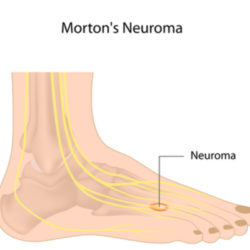Surgical Excision of Morton's Neuroma
Book a free Intro call today to discuss your treatment options for Morton's Neuroma
What is Surgical Excision of Morton's Neuroma

Benefits and Complications of Surgical Excision of Morton's Neuroma
The Benefits of Surgery
The aim and main benefit of surgery is to relieve pain and, therefore, improve mobility.
Complications & Risks linked to Surgery
Infection: There is a small risk of developing a post operative infection. This risk is increased if you are diabetic, suffer from rheumatoid disease or if you smoke.
Persistent pain: This may be due to a Stump Neuroma, another Morton’s neuroma (in a different webspace) or nerve irritation.
Scarring: Any type of surgery will leave a scar. Occasionally this may be painful or inflamed.
What to Expect Following Surgery
IMPORTANT POST OPERATIVE ADVICE
Elevation
Elevate the foot as much as possible to help to significantly reduce swelling.
Keep the wound sites covered
The wound must be kept dry and clean until healed; stitches are usually removed about 2 weeks following the procedure. You should avoid getting the foot and bandages wet whilst bathing.
Rest
We advise that you rest for a few days. Those with a sedentary type of employment will probably be able to return to work within 7-10 days of the procedure but those whose employment involves long periods on their feet may need to refrain from work for 3 to 4 weeks. However, this is an individual decision and each person has a different speed of recovery.
Driving
You may resume driving a manual car about 2 weeks after your operation. If your drive an automatic car and your left foot only has been operated on, you may be able to resume driving earlier. In all cases, you should sit in a stationary car and check that you are able to perform an emergency stop and drive safely. You should check with your insurance company that your cover is valid after your surgery.
Kent’s Holistic Foot & Ankle specialists
The Sajid Shariff clinic is a private orthopaedic clinic based in SE London and Kent that specialises in surgical and non-surgical treatment of foot and ankle conditions including Morton's Neuroma, plantar fasciitis, ankle sprains, bunions and achilles tendonitis.

Keep an eye on the shape of your feet; if you see changes see a doctor to find out if there are any recommendations to prevent hallux valgus from forming

Use a variety of exercises to stretch your feet and calves

Try to avoid shoes that have a heel or pointed toe

